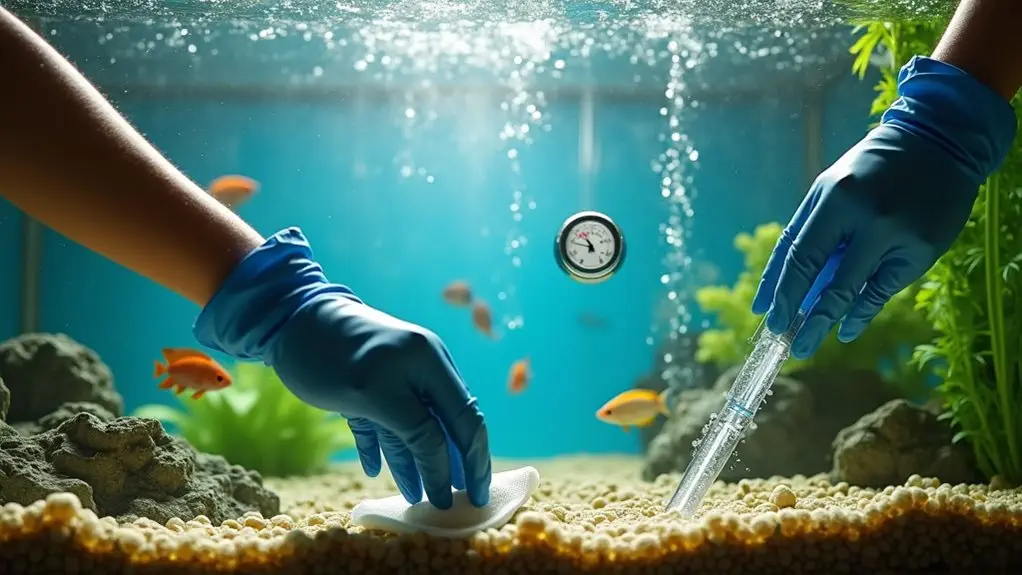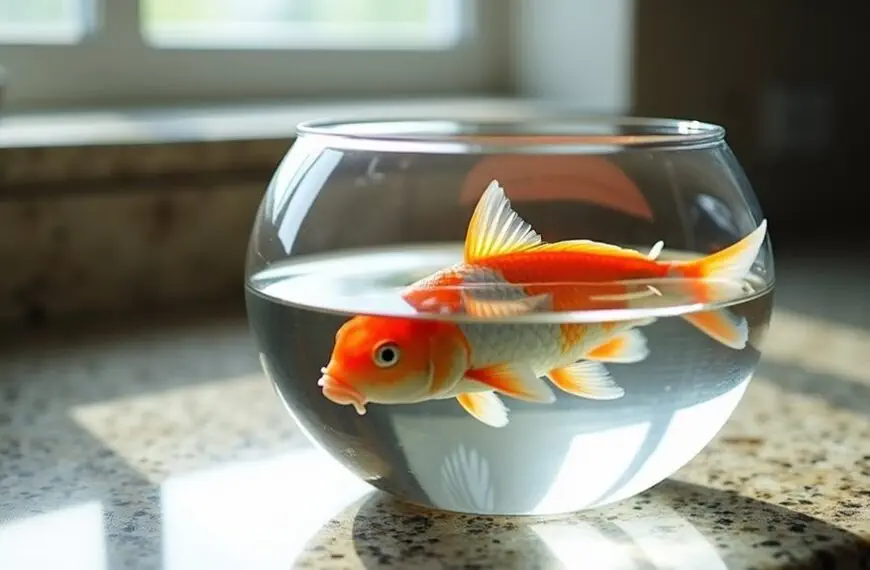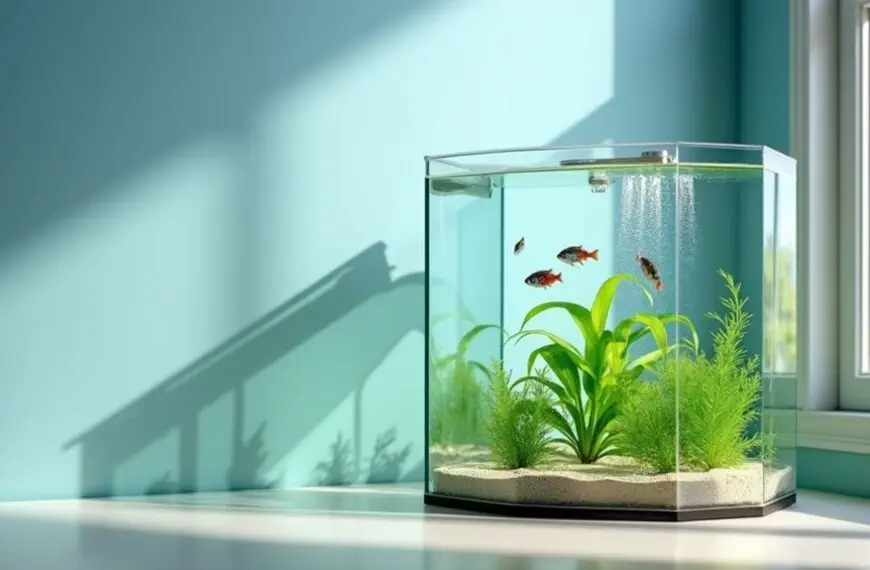To clean your fish tank effectively, start by gathering dedicated supplies like a gravel vacuum, algae scrubber, and separate bucket. Turn off all equipment, then clean the glass using magnetic cleaners for inside surfaces and a microfiber cloth for outside spots. Remove and clean 25-50% of decorations at a time to minimize fish stress. Vacuum the gravel to remove debris while performing a 10-15% water change with properly conditioned water. Don't forget to clean your filter using tank water, not tap water, to preserve beneficial bacteria. There's a whole world of tank maintenance tips waiting to make your aquatic friends happier and healthier.
Contents
Getting Ready for Tank Cleaning
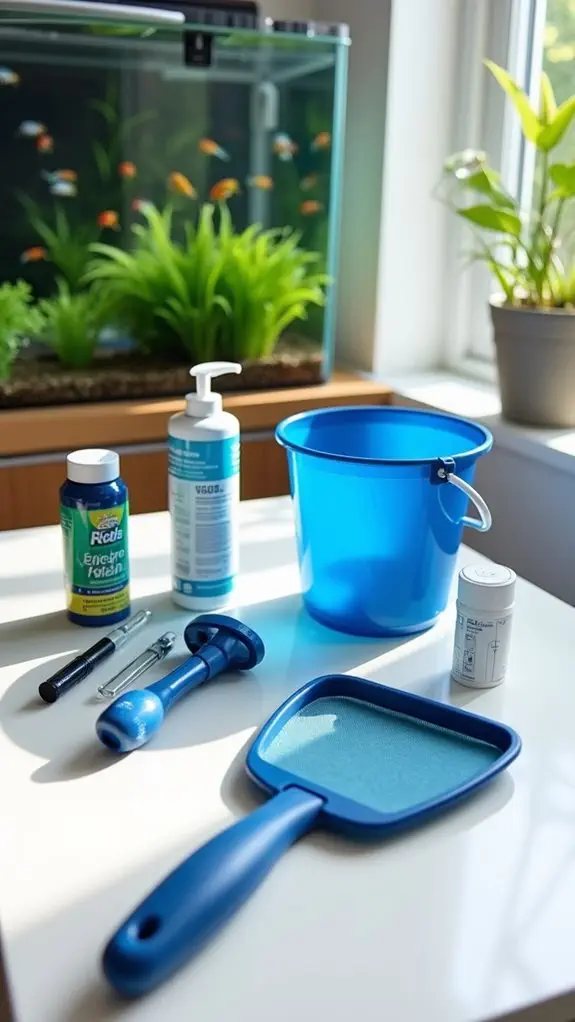
Before starting your fish tank cleaning routine, you'll need to gather the right equipment and prepare your workspace properly. Your first step is to collect all your dedicated cleaning supplies, including a separate bucket, gravel vacuum, and algae scrubber.
Don't be tempted to grab that kitchen sponge – your aquarium needs its own cleaning tools to maintain tank safety and prevent contamination. Monthly maintenance procedures will help ensure optimal health for your aquatic pets. For healthy fish and proper water quality, plan on completing water changes of 10-15% every two weeks, as this practice helps to reduce ammonia and nitrites in your aquarium.
Next, you'll want to prepare your aquatic environment by turning off and unplugging all equipment. If you're planning a deep clean, set up a temporary home for your finned friends, making sure to cover both containers to prevent any escape artists from making a break for it!
Keep a close eye on water temperature throughout the process, as sudden changes can stress your fish. It's also important to minimize fish stress during cleaning by avoiding sudden water parameter fluctuations, as this can lead to increased aggression among tank inhabitants.
Before diving into your cleaning schedule, get your new water ready. Mix it in a separate bucket, add your water conditioner, and use a thermometer to match the tank's temperature.
Remember to test those important water parameters – pH, nitrite, and nitrate levels – to guarantee your fish will return to the perfect environment. Your preparation now will make the actual cleaning process smooth sailing!
Glass and Aquarium Surface Care
While maintaining crystal-clear aquarium glass may seem challenging, it's one of the most important aspects of fish tank care. Always wash your hands thoroughly before starting any aquarium maintenance to prevent contamination.
You'll need to reflect on different glass types, including standard glass and acrylic, as each requires specific cleaning tools and techniques. Regular maintenance according to a consistent cleaning schedule helps prevent buildup of algae and residues. Your cleaning frequency should align with your tank's needs, typically every 1-2 weeks for ideal results, especially in maintaining balanced water quality that supports fish health.
For effective glass maintenance, here's what you'll want to focus on:
- Inside surfaces: Use a magnetic cleaner for regular upkeep, moving in circular motions to prevent scratches. For stubborn algae, try aquarium-specific sponges like the Dennerle Clenator.
- Outside surfaces: Keep a microfiber cloth handy for streak-free cleaning, and don't forget to tackle those pesky water spots with white vinegar.
- Tough deposits: When you're faced with stubborn residues, reach for specialized tools like Tetratec Easy Wipes or a proper algae scraper.
Decorations and Rock Maintenance
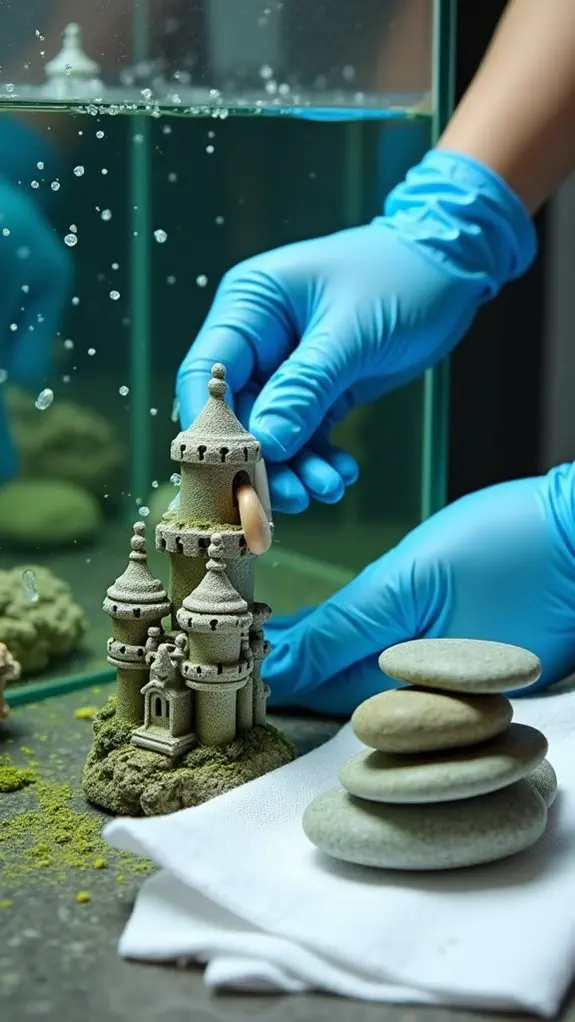
A spotless aquarium isn't complete until you've addressed the decorations and rocks that bring your underwater world to life.
Whether you've got plastic plants, ceramic castles, or natural stones, all decoration types need regular maintenance to stay pristine and safe for your aquatic friends. It's best to clean only 25% to 50% of decorations at once to minimize stress on your fish. Remember to avoid soap when cleaning any aquarium decorations to prevent harm to fish. Clean decorations support optimal water quality, which is critical for the health of your fish.
You've got several effective cleaning methods to choose from, depending on how dirty your decorations are.
For routine cleaning frequency, which should be every few weeks, a simple scrub with an aquarium sponge and soft brush will do the trick.
When you're dealing with stubborn algae or calcium buildup, you'll want to step up your game with a vinegar solution – it's gentle yet effective.
For those really tough cases, a diluted bleach solution can work wonders, but remember to wear gloves and rinse thoroughly!
If you're not comfortable using chemicals, try the hot water method or a hydrogen peroxide treatment.
These alternatives are particularly great for plastic decorations, and they'll keep your underwater decor looking fresh and inviting.
Just remember to let everything dry completely before returning it to your aquarium – your fish will thank you!
Gravel and Substrate Cleaning
The foundation of a healthy aquarium lies in proper gravel and substrate maintenance. When it comes to gravel maintenance, you'll want to use a gravel vacuum or siphon every 2-4 weeks to remove debris while keeping your substrate in place. Different substrates can influence the overall health and ecosystem dynamics of your tank, so it's essential to choose wisely. Using 1-2 pounds of gravel per gallon ensures proper coverage for your tank's ecosystem.
Think of it like vacuuming your carpet, but underwater! Remember, you're not just cleaning – you're helping maintain the delicate ecosystem your fish call home. Using a vacuum design system allows you to clean thoroughly without accidentally removing the gravel itself.
For effective substrate care, here are three essential tips you won't want to skip:
- Never use cleaning products like soap or bleach – they're harmful to your aquatic friends.
- Clean your gravel in sections, just like mowing a lawn, to guarantee thorough coverage.
- Keep at least 50% of your tank's water during cleaning to protect beneficial bacteria.
If you're setting up a new tank, you'll need to prepare your gravel first. Take it outside and rinse it thoroughly using a clean sieve until the water runs clear.
It's like giving your gravel a shower before it moves into its new home! Regular maintenance might seem tedious, but it's vital for keeping your underwater world happy and healthy.
Water Changes and Filtration
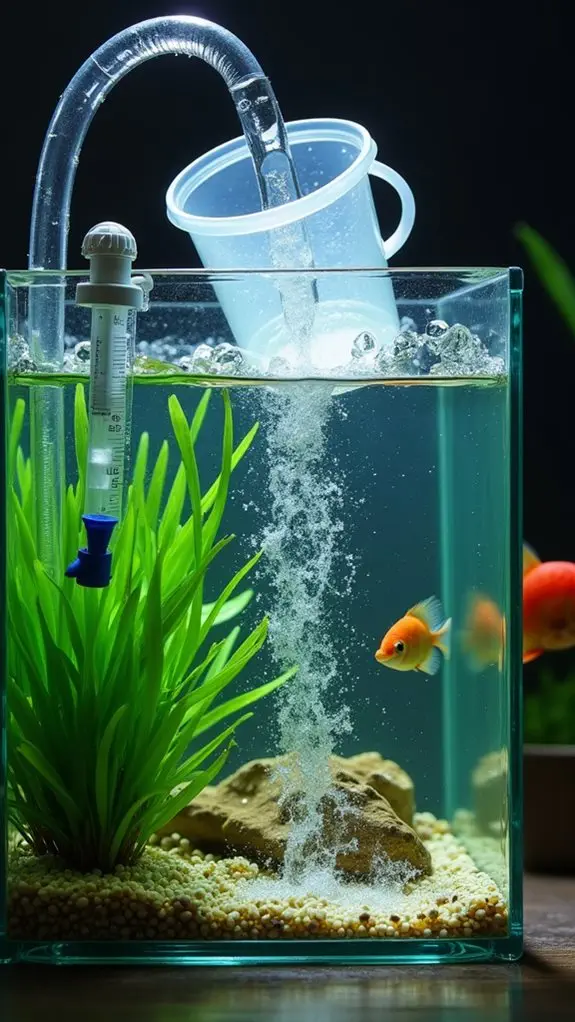
Proper water management stands at the heart of a thriving aquarium ecosystem. You'll want to change 10-15% of your tank's water weekly, though heavily stocked tanks might need up to 25%. Think of it as giving your fish a fresh, clean environment without turning their world upside down – too much change can shock them!
When it comes to filter types, you've got several options working together to keep your water quality in top shape. Your filter system combines biological filtration (those helpful bacteria breaking down waste), chemical filtration (tackling unwanted substances), and mechanical filtration (catching those floating particles). Simply topping off evaporated water won't maintain proper water quality like regular changes do. Canister filters are excellent choices for aquariums over 10 gallons due to their high capacity for filtration media. Maintaining clean water lowers the risk of stress and illness among your fish, keeping them healthy.
Whether you're using a hang-on power filter or a sponge filter, they're all working hard to keep your finned friends happy.
Remember to clean your filters gently using the water you've collected during changes – never tap water! You don't want to accidentally wash away those beneficial bacteria that keep your tank's ecosystem balanced.
It's like maintaining a tiny underwater city – each part plays its role in keeping everyone healthy and swimming happily. Regular maintenance keeps everything running smoothly without stressing out your aquatic pals.
Frequently Asked Questions
How Often Should I Deep Clean My Fish Tank?
You'll need to perform deep tank maintenance once a month, but your cleaning schedule depends on factors like fish population and filtration quality. Weekly water changes and bi-weekly substrate cleaning are also essential.
Can I Use Vinegar to Clean My Fish Tank?
Yes, you can use vinegar! It's an effective cleaner with many benefits like removing algae and calcium deposits. Just dilute it 1:1 with water, remove your fish first, and rinse thoroughly afterward for safe cleaning.
Should I Remove Fish While Cleaning the Tank?
You shouldn't remove your fish while cleaning, as it causes unnecessary fish stress. Keep them inside and use proper cleaning techniques like gravel vacuuming and glass scrubbing while maintaining their comfortable environment.
What Happens if I Accidentally Get Soap in the Tank?
If you've got soap in your tank, act fast! Do a 50% water change to reduce tank toxicity. The soap residue can harm your fish and kill beneficial bacteria. Add vinegar to help neutralize it.
Can I Reuse Old Filter Media From Another Tank?
You can reuse filter media from another tank, but only do it carefully during aquarium maintenance. Don't move media between freshwater and saltwater setups, and always clean it gently in tank water to preserve bacteria.
Final Thoughts
Regular tank maintenance isn't just about keeping your aquarium looking pristine – it's about creating a healthy home for your finned friends. You'll find that establishing a cleaning routine, from wiping glass to changing water, becomes second nature with practice. Remember, a clean tank means happy, healthy fish, and there's nothing better than watching your underwater pals thrive in their crystal-clear paradise. Keep up the good work, and your fish will thank you!

